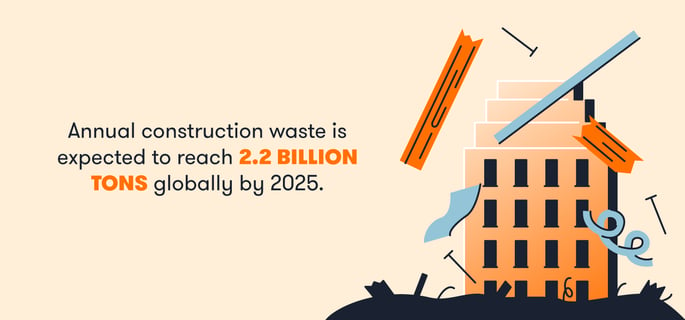Construction Waste: How Bad Is It?
Construction waste is bad for the environment and the construction industry. Here are the statistics to know about construction waste and how to fix it.
Modular Home and Pool Express
10/6/20233 min read


Construction Waste: How Bad is It?
The construction industry in the United States contributes significantly to the country's overall waste production, which is already excessive. Here are some eye-opening statistics regarding construction waste:
By 2025, global annual construction waste is expected to reach 2.2 billion tons (Transparency Market Research).
Construction and demolition (C&D) waste make up approximately 23% of the national waste stream (BTS).
In 2018 alone, the U.S. generated over 600 million tons of construction-related waste (EPA).
C&D waste generation in the U.S. increased by a staggering 342% from 1990 to 2018 (EPA).
Between 2005 and 2018, C&D waste levels grew more than 10 times faster compared to the period from 1990 to 2005 (EPA).
Here are some specific insights into construction waste disposal:
C&D waste accounted for 30–40% of the total solid waste stream globally in 2022 (Science Direct).
Up to 30% of building materials delivered to construction sites can end up as waste (Science Direct).
Construction and demolition projects filled U.S. landfills with nearly 145 million tons of waste in 2018 (EPA).
More than 75% of construction waste from materials like wood, drywall, asphalt shingles, bricks, and clay tiles ends up in landfills (EPA).
Concrete and asphalt concrete constituted 85% of all U.S. C&D waste in 2018 (EPA).
The construction industry in the United States contributes significantly to the country's overall waste production, which is already excessive. Here are some eye-opening statistics regarding construction waste:
By 2025, global annual construction waste is expected to reach 2.2 billion tons (Transparency Market Research).
Construction and demolition (C&D) waste make up approximately 23% of the national waste stream (BTS).
In 2018 alone, the U.S. generated over 600 million tons of construction-related waste (EPA).
C&D waste generation in the U.S. increased by a staggering 342% from 1990 to 2018 (EPA).
Between 2005 and 2018, C&D waste levels grew more than 10 times faster compared to the period from 1990 to 2005 (EPA).
Here are some specific insights into construction waste disposal:
C&D waste accounted for 30–40% of the total solid waste stream globally in 2022 (Science Direct).
Up to 30% of building materials delivered to construction sites can end up as waste (ScienceDirect).
Construction and demolition projects filled U.S. landfills with nearly 145 million tons of waste in 2018 (EPA).
More than 75% of construction waste from materials like wood, drywall, asphalt shingles, bricks, and clay tiles ends up in landfills (EPA).
Concrete and asphalt concrete constituted 85% of all U.S. C&D waste in 2018 (EPA).
Despite these concerning figures, there is hope in recycling efforts within the construction industry:
New construction contributed just 5.5% of all U.S. C&D waste in 2018 (EPA).
In the same year, 76% of all C&D waste in the U.S. was recovered or recycled (EPA).
Over 95% of concrete and asphalt concrete waste, major contributors to C&D waste, was recovered in 2018 (EPA).
C&D recycling opportunities led to the creation of 175,000 U.S. jobs in one year (EPA).
Recycling steel, a common construction material, prevents significant CO2 emissions, conserves resources, and saves energy (The World Counts, AISC).
Utilizing recycled and recyclable materials in construction projects can significantly reduce waste and environmental impact.
Steel, for instance, is made mostly from recycled steel scrap, and asphalt concrete has become highly recyclable. Initiatives like material banks storing recycled building materials further promote sustainable practices in the industry.
Where does Modular Steel Panels fit?
Almost all steel used in the construction industry is made up of recycled material. Unlike wood-framed structures, steel framed structures are recycled thereby reducing waste and landfill use.
There is almost zero waste on a Modular Home and Pool Express build! This not only is great for the environment, but it also produces a MUCH safer worksite and saves tremendous money on the cost of dumpsters and landfill fees.


All Rights Reserved: 2021-2024
Offices: Tampa - Istanbul - Hong Kong
